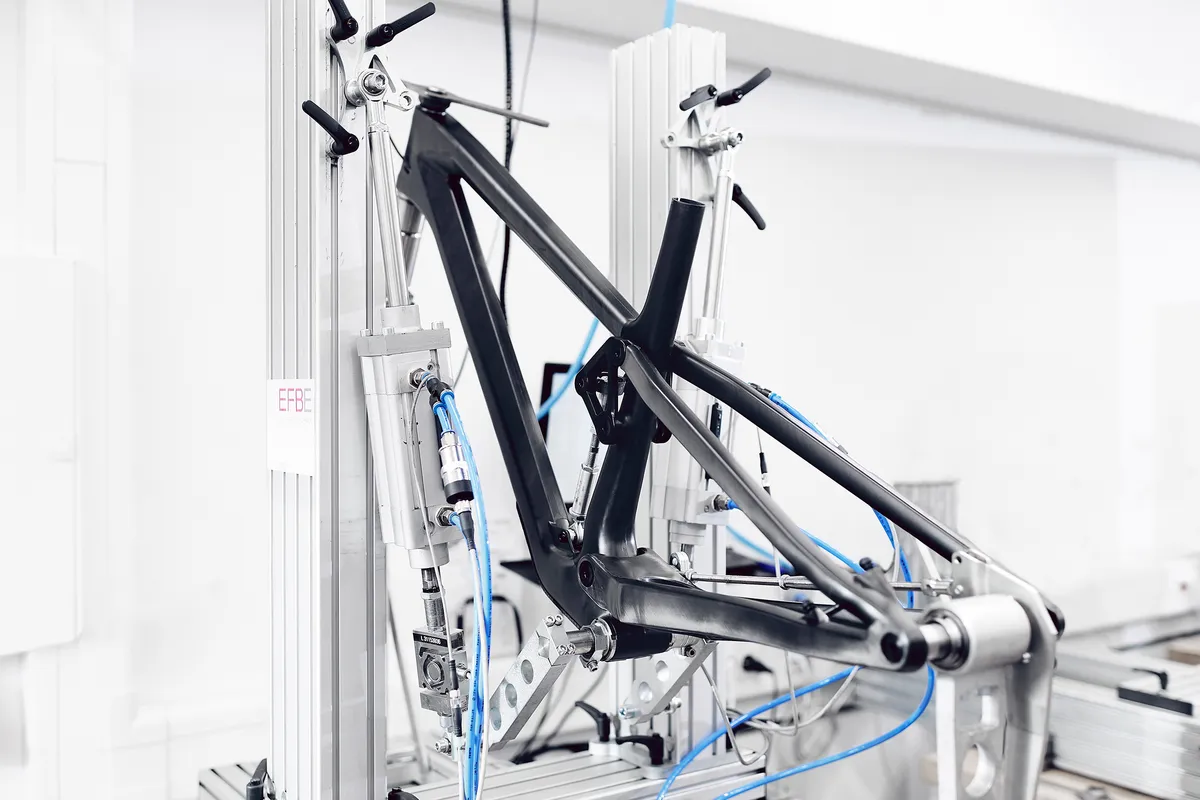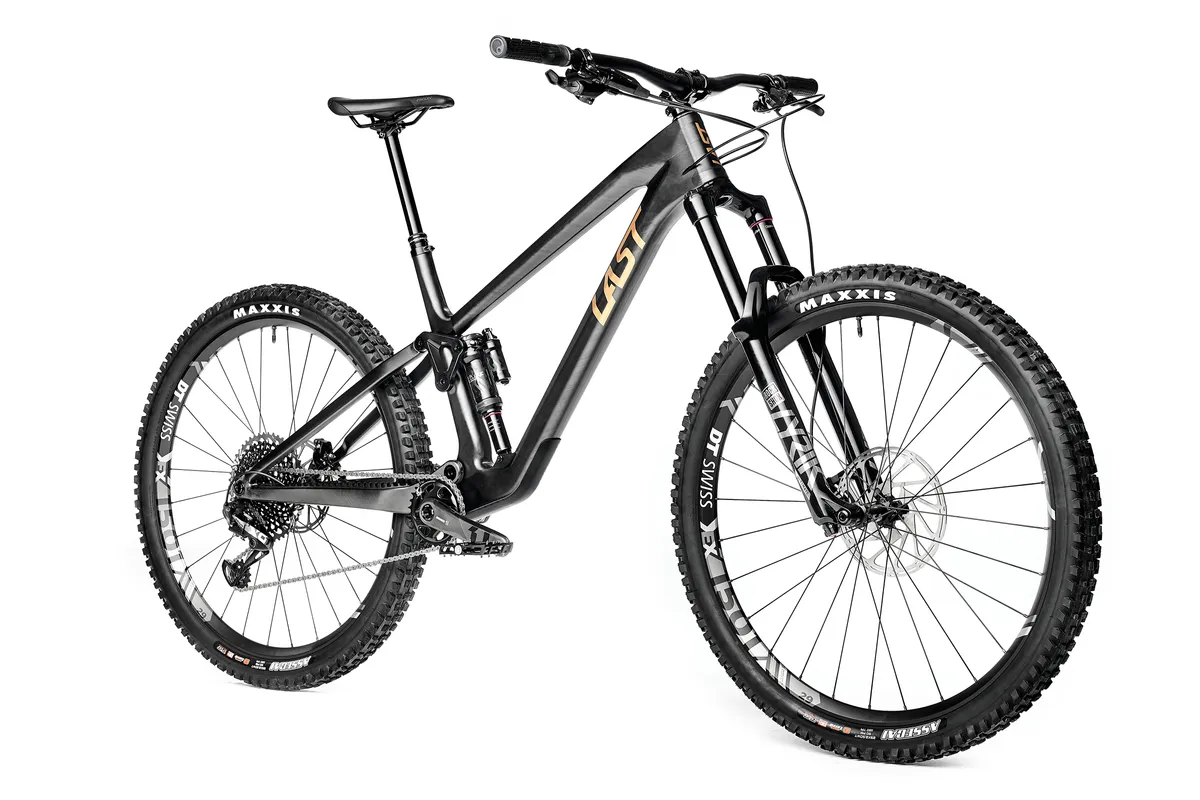German manufacturer Last has launched its latest enduro bike – the 29in-wheeled Tarvo – with a bold claim that it's "the lightest enduro [bike] there is".
With a headline frame-only claimed weight of 2.08kg – nearly 1kg lighter than the Glen, its aluminium-framed enduro bike – and full builds as low as a claimed 12.4kg, we wondered how Last has managed to make an enduro bike with a five-year warranty so light compared to the competition.
- Mountain bike groupsets: everything you need to know
- Mountain bike wheel sizes: 26in, 650b and 29in explained
- The best enduro bikes as rated by our expert testers
Last Tarvo frame construction

Manufactured from Last's monocoque carbon – where the front and rear parts of the frame are produced in one mould – Last claims, the frame has one "consistent laminate structure without any weak points", eliminating any joins, bumps or excess carbon material layup inside the frame.

On top of this, Last uses an autoclave process to create pressure on the prepreg layup to turn it into a load-bearing structure. The industrial autoclave process is where a composite part is placed inside a sealed, pressurised and temperature-controlled vessel to help fabricate it to the required specifications.
It also uses a vacuum inside the carbon to remove unwanted air. Last claims this helps to reduce the amount of carbon required to make the bikes strong enough to meet stringent tests.
The prepreg process begins in Japan where the fibre is impregnated with resin. A further preparation process is carried out in Italy where 90-degree and unidirectional carbon fibre layers are used.
Because the manufacturing process is so refined, Last boasts it doesn't need to sand its frames after the lay-up process.

The new Last Tarvo has been awarded the highest level of ASTM F2043-13 approval. This accolade has given Last the confidence to offer the Tarvo with a bikepark-certified five-year warranty.
Last Tarvo frame features
The frame's pivots use stainless steel bearings from Endurobearings and M14 hardware.
An optional down tube storage compartment, akin to Specialized's SWAT system, can be specced for an extra €199, and the the bottle cage mount sits on the lid.

Last has chosen to spec SRAM's Universal Derailleur Hanger arguing that it's more widely available than a proprietary solution.
It has a 73mm BSA threaded bottom bracket but lacks inbuilt ISCG05 tabs. Instead, an ISCG05 adaptor needs to be fitted to the bottom bracket when it's screwed into the frame.

It has full-length internal cable routing, 12x148mm rear axle spacing, can have up to a 203mm rear disc rotor and up to 2.5in wide tyres.
The Tarvo's available in raw carbon without varnish — thanks to Last's ultraviolet light-stable carbon fibre layup — with varnish or in a delightfully fetching matt metallic blue. Custom colour options are also available.
Last Tarvo geometry figures
Luckily for potential Tarvo riders, the weight savings haven't caused any compromises in the frame's geometry.
It's available in four sizes, named according to their typical rider heights in centimetres: 165, 175, 185 and 195.
Reach figures look long, seat tube angles steep, wheelbases large and chainstays get longer with each increase in size.
| Size | 165 | 175 | 185 | 195 |
|---|---|---|---|---|
| Reach (mm) | 429 | 454 | 485 | 518 |
| Stack (mm) | 622 | 631 | 640 | 649 |
| Head tube angle (degrees) | 64 | 64 | 64 | 64 |
| Seat tube angle (degrees) | 76 | 76 | 76 | 76 |
| Seat tube length (mm) | 385 | 415 | 455 | 510 |
| Chainstay (mm) | 430 | 432 | 438 | 444 |
| Head tube length (mm) | 95 | 110 | 120 | 130 |
| Wheelbase (mm) | 1194 | 1227 | 1268 | 1312 |
| Top tube length (mm) | 487 | 532 | 568 | 620 |
Although the Tarvo's a 29in-wheeled bike, it's also available in a mullet 27.5in rear wheel, 29in front wheel setup. Last makes this possible by changing out the suspension link affecting the head tube and seat tube angles by a mere 0.2 degrees.
With the MX link, suspension increases from 160mm for the 29er to 170mm.
Last Tarvo suspension details

Last claims the Tarvo's suspension is particularly progressive, with an overall 55 per cent increase in progression through its 160mm of travel.
It's also tuned each of the Tarvo's sizes to have a slightly different kinematic resulting in more anti-squat as the size of frame increases. This should compensate for a predicted increase in average rider mass and higher centre of gravity.
- Mountain bike suspension setup: video guides to help you get the most from your bike
- The ultimate guide to mountain bike rear suspension systems

At sag for a 24-tooth cassette sprocket and 30-tooth chainring, anti-squat numbers range from approximately 114 per cent to 118 per cent, but in the biggest 50-tooth climbing gear the anti-squat figures are identical.
Anti-rise figures at sag are just below 100 per cent, which means the bike's suspension has a propensity to extend under braking, hypothetically making the suspension more active.
However, there are plenty of factors to consider and if you'd like to find out more check out our ultimate guide to mountain bike rear suspension systems.
The Tarvo's got 160mm travel with 29in wheels or if it's using the MX link to make it a mullet bike it has 170mm of travel.
Instead of using a bearing pivot on the seat or chainstays, Last's rear suspension system relies on flex pivot. Although it doesn't go into specifics, we believe the majority of the rear end's suspension flex will come from the seatstays.

It's compatible with 205x65mm trunnion metric shocks from both Fox and RockShox.
Last Tarvo specifications and prices

Last offers deep customisation on its Tarvo frame and full bike kits.
The cheapest option is to buy a raw carbon frame only in either 29in or mullet configuration, retailing for €3,599.
Adding blue paint will set you back €399, the storage compartment €199, and custom colour will cost €799 over a raw bike.
Full builds start at €5,799 and include a RockShox SuperDeluxe Ultimate RTC rear shock, RockShox Lyrik Select RC fork, Reverse handlebar and stem, SRAM G2 brakes, an SLX drivetrain and DT Swiss wheels.

Upgrading to a brand new Fox 38 fork will cost €430, while opting for SRAM's X01 groupset is an increase of €360.
The priciest build we could spec – ticking every box on Last's option list – topped out at €11,230, slightly less than Pivot's 2020 Switchblade Team XX1 AXS before the Fox Live Valve upgrade.
Is the Last Tarvo the lightest enduro mountain bike on the market?
That's a tricky question to answer. Last doesn't divulge the exact details on the frame size or build kit it used to reach its headline 12.4kg weight figure, and doesn't mention whether the bike was set up tubeless, with or without sealant, or whether the tyres were pumped up with helium.
I jest, but chasing headline weight figures, while great for the marketing department, isn't always best for the consumer.
However, if it has managed to produce the lightest enduro bike available, I'll be the first to doff my cap.
To help you out, here's a list of bike we've recently tested with their actual weight figures and frame sizes. The closest competitor – weight-wise – is Scott's Genius 900 Tuned in a size large at 13kg and not a gram more.
Recently-tested enduro bike weights, from heaviest to lightest with size tested
- Whyte G-170C RS 29 V2: 15.24kg (M)
- Cube Stereo 170 SL 29: 15.01kg (18in)
- Giant Reign 29 1: 14.98kg (M)
- Nukeproof Mega 290 Elite Carbon: 14.9kg (M)
- Identiti Mettle II RC: 14.81kg (M)
- Radon Swoop 170 10.0: 14.81kg (17in)
- Mondraker Superfoxy Carbon R: 14.8kg (XL)
- Specialized S-Works Enduro 29: 14.67kg (S3)
- Orbea Rallon M10 MYO: 14.5kg (XL)
- Specialized Stumpjumper EVO Pro 27.5: 14.26kg (S2)
- NS Bikes Define 150 1: 13.85kg (L)
- Santa Cruz Hightower CC X01 Reserve: 13.7kg (M)
- Intense Primer S Pro: 13.67kg (L)
- Mondraker Foxy Carbon XR: 13.52kg (M)
- Scott Genius 900 Tuned: 13kg (L)

